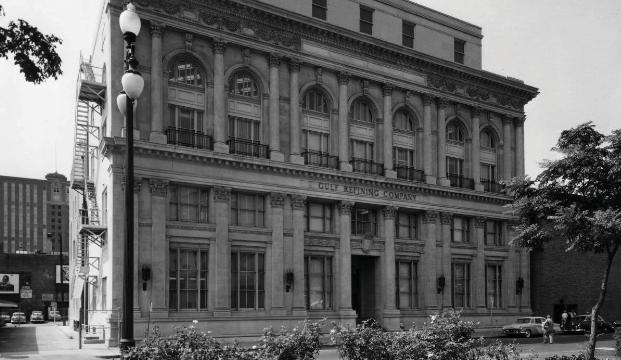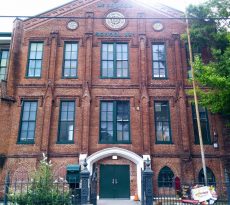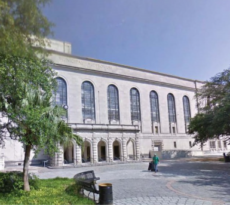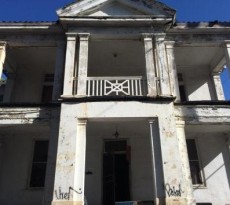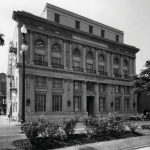
Photo via Tulane.Edu
The Louisiana Landmarks Society (LLS), which promotes historic preservation through education, advocacy, and operation of the Pitot House, earlier this week announced the eighteen winners of the 2015 Louisiana Landmarks Society Awards for Excellence in Historic Preservation.
The awards honor projects completed in Orleans Parish (outside of the French Quarter) in 2014 which represent outstanding examples of restoration or rehabilitation of historic buildings, as well as new construction in historic neighborhoods.
The 2015 Louisiana Landmarks Society Awards for Excellence in Historic Preservation winners are:
1. Tulane School of Social Work / 127 Elk Place
DonahueFavret Contractors, Eskew+Dumez+Ripple, Tulane University
Contained in the former Elks Building, a neo-classical structure built in 1917, the School of Social Work occupies the third and fourth floors in a repurposed space that balances design, safety and security with user need, program and institutional identity, while providing an inviting learning, teaching and collaboration environment.
2. 518 Natchez (Check out the amazing pics!)
studioWTA, Vieux Nouveau Properties LLC
516 Natchez is the rehabilitation of two adjoined three-story brick row houses in the Central Business District. An exercise in urban density, the building houses a ground floor office space and a total of five apartments in an 8,200 square foot volume. Historic elements of the buildings’ architecture were preserved wherever possible, the highlight being an intricately detailed bathroom within a vaulted brick structure on the ground floor of the building.
3. 850 Tchoupitoulas
Trapolin-Peer Architects, Woodward Design+Build
This mid 19th century building is one of the few remaining structures designed by James Dakin, a preeminent architect of that time. The first floor is open to accommodate retail tenant space, and the upper two floors serve as the office space. In keeping with the building’s historic integrity, the granite sills and masonry walls common to the Warehouse District were preserved and exposed as architectural design elements.
4. 2400 Canal
Clark/McCarthy Healthcare Partners, Eskew+Dumez+Ripple, Landis Construction LLC, NBBJ, Rozas Ward Architects, Southeast LA Veterans Health Care System, Woodward Design Group
The Pan American Life Insurance Company Building at 2400 Canal Street is listed individually on the National Register of Historic Places as a significant representation of post-World War II International Style architecture. Original features include an elevated terraced entrance and interior courtyard. After being out of service and an eyesore for years, it functions today as the administration building for the new VA hospital.
5. Bienville Avenue Residences
GCE Green Development LLC
2423-25, 2431-39, 2416-18, and 2415-17 Bienville Avenue, near North Broad Street, were vacant, blighted historic structures left to disinvestment before and after Hurricane Katrina. GCE Green Development, LLC saw the opportunity to utilize the existing structures to create historic, energy efficient, high quality housing close to the new hospital corridor.
Carver Theater LLC, Perez APC
Opened in 1950 as a movie theater for African Americans during the era of segregation, the Carver Theater is listed in the National Register of Historic Places. After the shutdown of the movie screen in 1980, the Carver Theater housed a medical clinic and then sustained damage during Hurricane Katrina. Careful rehabilitation and a new addition have returned the historic Carver Theater to its proper place as a community entertainment venue for a new generations of New Orleanians.
7. Faubourg Duchamp
Pat O’Brien Developments LLC
Faubourg Duchamp was named for an area bounded by Derbigny, Roman, Kerlerec and Columbus Streets. In 1969, Pat O’Brien purchased the Creole cottage at 1717 Kerlerec built by Charles Martinez in 1842 and carefully restored this property. She has gone on to restore twenty blighted properties in this area. Ms. O’Brien considers her greatest achievement to have been attracting tenants from different socio-economic levels consistent with the long-time character of her neighborhood. Ms. O’Brien has demonstrated that cultural and ethnic diversity makes for a viable, safe and exciting neighborhood.
8. Il Mercato
Concordia Group LLC, Cypress Building Conservation, Joel Catering and Special Events, NANO LLC, Scott Ornamental Iron LLC, Vista Landscaping, YKM Consulting LLC
Designed in 1931 by New Orleans architect Sam Stone Jr., the building at 1911 Magazine Street was originally a market. Restoring the building to its original condition while adapting it to its new use as an event space and maintaining eligibility for historic tax credits posed unique challenges for the architects and contractors working on this project. The rehabilitation of this building puts a neighborhood eyesore back into use and revitalizes a building that might have faced demolition and replacement on valuable Magazine Street real estate.
9. 1241 Josephine Street
Marcy Willmann, MBWillmann Design
1241 Josephine is the restoration and renovation of an 1880’s Victorian home with a corner store to a single family home. The property had been divided into three apartments. All original components of the home were kept intact, refurbished and reinstalled wherever possible. After its restoration the house presents well at night with its warm white color and illumination by Edison bulbs. Passers-by have commented on how happy they were to see this corner come back to life.
10. New Orleans Military and Maritime Academy
NOMMA Real Estate LLC, Woodward Design+Build, Woodward Design Group
The New Orleans Military and Maritime Academy at Federal City in Algiers involved the rehabilitation of existing historic structures, as well as new construction to create one high school campus. The resulting school building offers classroom spaces, music and band rooms, a cafeteria, labs, locker rooms, and administrative offices for the New Orleans Military and Maritime Academy. Designed and built with a goal of LEED Certification, the project is currently finalizing documentation to receive this designation.
11. Myrtle Banks Redevelopment
Alembic Community Development, Eskew+Dumez+Ripple, Harmon Engineering , Mazzetti, Ryan Gootee General Contractors
With a nod to community redevelopment and sustainability, a project team working in one of New Orleans’ historic neighborhoods has breathed life into a fire-ravaged brick schoolhouse that is over a hundred years old. Designed to meet the contemporary needs of the surrounding neighborhood, the Myrtle Banks school building was converted into a 23,000-square-foot public food market with office space for small businesses and nonprofits. As a result of the project’s successful completion, the Myrtle Banks Redevelopment has become a model for adaptive reuse projects in the Crescent City.
Grenald Waldron Associates, Kirkegaard Assocites, Kronberg Wall, Landis Construction, Leppard Johnson & Associates, New Orleans Jazz Orchestra, Redmellon Restoration and Development, Stability Engineering
The New Orleans Jazz Market project involves the adaptive reuse of the historic Dryades Market into a new home for The New Orleans Jazz Orchestra (NOJO). The historic renovation transformed the former market and discount store into 14,000 square feet of space, including a state-of-the-art 350-seat flexible performance space for NOJO along with practice facilities and educational space. The renovated space will not only serve as a permanent performance home for the New Orleans Jazz Orchestra but also as a community space for events and educational programs.
13. PolyBar Project
Ashe Cultural Center, CCWIV Architecture LLC , FH Myers Construction, Gulf Coast Housing Partnership, Neighborhood Restoration of Baton Rouge, Tulane City Center
The Polymnia-Baronne (PolyBar) project, located within the Central City National Register Historic District, is a significant contributor to the revitalization of the Oretha Castle Haley Cultural Corridor and represents an exciting expansion for the two commercial tenants: Efforts of Grace (aka Ashe Cultural Arts Center) and Tulane City Center. The properties include 1725 Baronne Street, a one-story brick structure constructed in 1926 as a department store and 1731 Baronne Street, a two-story brick and concrete structure built in 1924 as a New Orleans Public Service, Inc. streetcar switching station.
14. Professor Longhair House
Pat Byrd, Project Homecoming, Rick Fifield Architect, Tipitinas Foundation, United Way
The two-story wood frame residence at 1738 Terpsichore Street was the only home of Henry Byrd, known to his fans as Professor Longhair. The house had fallen into a state of disrepair prior to Hurricane Katrina, and the storm rendered the residence uninhabitable. Following an earlier failed attempt to rehabilitate the home, a new project team joined the owner Pat Byrd, daughter of Henry Byrd, to restore the appearance of the building to a moment in time when Professor Longhair owned and occupied the home. Using architectural details that remained in the building, the renovation attempts to faithfully convey the sense of the structure as it was when occupied by this music legend.
15. Roman-Bienville Homes
CIS Architects, Neville Development, St. James AME Church, Titan Construction of LA
Roman-Bienville Homes is an affordable housing project located in the Mid-City neighborhood of New Orleans. The project consists of eleven buildings (existing and new construction) that house 31 units of affordable housing. Five of the buildings are rehabilitations of existing homes. The project has helped redefine the neighborhood and sensitively relates to the streetscape.
16. Southern Food and Beverage Museum
Office of Jonathan Tate, SoFAB Institute, Woodward Design+Build
The building, built in 1912 as the Dryades Market, was one of 34 public markets in New Orleans. The basic intent of this latest renovation of the building as the new home for the Southern Food and Beverage Museum was to strip away the layers accumulated throughout the years to expose what remained of the original structure. The approach attempted to accommodate the programmatic needs of the new museum, while emphasizing the spatial and physical characteristics of the building’s original role as a market.
17. Marais Apartments
HCI Architecture, LLC, HRI Properties , Landis Construction, Rick Fifield Architect
The rehabilitation of the historic Texaco Building, now the Marais Apartments, saw the transformation of the iconic 17-story, 113,000 square foot skyscraper into 112 residences designed for elderly individuals, including senior residents of the nearby Iberville public housing project. This adaptive reuse marks the first housing phase of the Iberville-Treme Choice Neighborhood Project, part of the transformation of the Iberville public housing project.
18. The George and Joyce Wein Jazz & Heritage Center
DonahueFavret Contractors, Eskew+Dumez+Ripple, New Orleans Jazz & Heritage Festival and Foundation, Rick Fifield Architect
Built in the 1870’s by Cuban developer Jules LeBlanc, the George and Joyce Wein Jazz & Heritage Center was once two separate townhomes. The townhomes were combined into one single Italianate-style building in the early part of the 20th century. In the rehabilitation, the façade remained relatively untouched, and the original shape and details of the front classrooms were retained, while being updated for optimal acoustics and energy savings. The rear half of the building, which lacked the historic resonance of the front, was rebuilt from the ground up into a modern performance space. Through a blend of old and new, the Wein Jazz & Heritage Center brings out the best, while preserving its impressive roots.
Nominations for the 2015 Awards were submitted from individuals, companies, and organizations. Of particular interest were projects which:
- Demonstrated that historic preservation could be a tool to revitalize older neighborhoods
- Showed that historic preservation is “green” and sustainable
- Supported the cultural and ethnic diversity of the preservation movement
- Were creative examples of saving a historic building
- Involved properties that utilized various federal or state tax incentive programs
- Represented new design that is appropriate to historic neighborhoods
The Selection Committee included: Louisiana State Historic Preservation Office’s Nicole Hobson-Morris; Tulane School of Architecture’s Professor Eugene Cizek; City archivist, Sally Reeves; Historic District Landmarks Commission’s Jim Amdal, Jesse LeBlanc and Elliott Perkins; architectural historian Hilary Irvin; LLS trustees Charles Berg AIA, Sandra Stokes, and Casey Stuart; and LLS Executive Director Walter Gallas.
